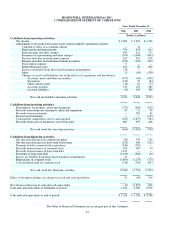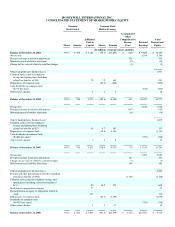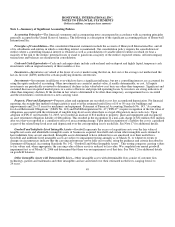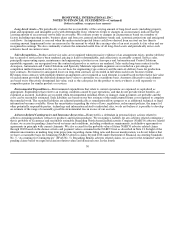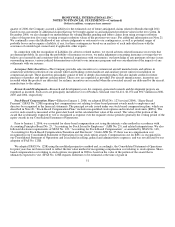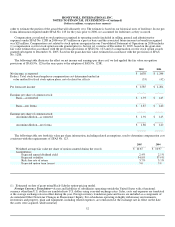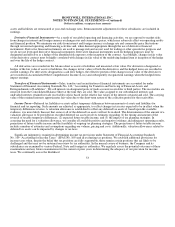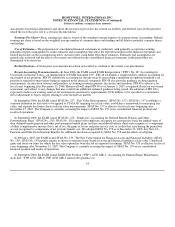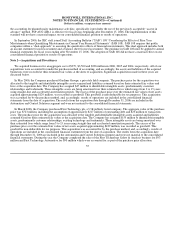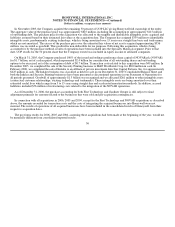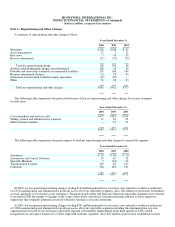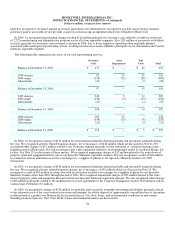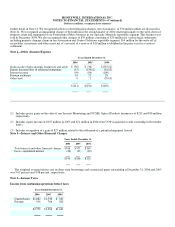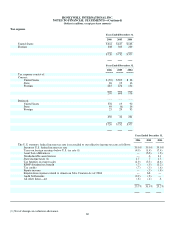Honeywell 2006 Annual Report Download - page 73
Download and view the complete annual report
Please find page 73 of the 2006 Honeywell annual report below. You can navigate through the pages in the report by either clicking on the pages listed below, or by using the keyword search tool below to find specific information within the annual report.
HONEYWELL INTERNATIONAL INC.
NOTES TO FINANCIAL STATEMENTS—(Continued)
(Dollars in millions, except per share amounts)
and amount of potential adjustments and adjust the income tax provision, the current tax liability and deferred taxes in the period in
which the facts that give rise to a revision become known.
Earnings Per Share—Basic earnings per share is based on the weighted average number of common shares outstanding. Diluted
earnings per share is based on the weighted average number of common shares outstanding and all dilutive potential common shares
outstanding.
Use of Estimates—The preparation of consolidated financial statements in conformity with generally accepted accounting
principles requires management to make estimates and assumptions that affect the reported amounts in the financial statements and
related disclosures in the accompanying notes. Actual results could differ from those estimates. Estimates and assumptions are
periodically reviewed and the effects of revisions are reflected in the consolidated financial statements in the period they are
determined to be necessary.
Reclassifications—Certain prior year amounts have been reclassified to conform to the current year presentation.
Recent Accounting Pronouncements—In June 2006, the FASB issued FASB Interpretation (“FIN”) No. 48 “Accounting for
Uncertainty in Income Taxes—an interpretation of FASB Statement 109”. FIN 48 establishes a single model to address accounting for
uncertainty in tax positions. FIN 48 clarifies the accounting for income taxes by prescribing a minimum recognition threshold a tax
position is required to meet before being recognized in the financial statements. FIN 48 also provides guidance on derecognition,
measurement, classification, interest and penalties, accounting in interim periods, disclosure and transition. FIN 48 is effective for
fiscal years beginning after December 15, 2006. Honeywell will adopt FIN 48 as of January 1, 2007 as required. Based on our current
assessment, and subject to any changes that may result from additional technical guidance being issued, the adoption of FIN 48 is
expected to reduce our existing reserves for uncertain tax positions by approximately $130 million, to be recorded as a cumulative
effect adjustment to equity, largely relating to state income tax matters.
In September 2006, the FASB issued SFAS No. 157, “Fair Value Measurements” (SFAS No. 157). SFAS No. 157 establishes a
common definition for fair value to be applied to US GAAP requiring use of fair value, establishes a framework for measuring fair
value, and expands disclosure about such fair value measurements. SFAS No. 157 is effective for fiscal years beginning after
November 15, 2007. The Company is currently assessing the impact of SFAS No. 157 on its consolidated financial position and
results of operations.
In September 2006, the FASB issued SFAS No. 158, “Employers' Accounting for Defined Benefit Pension and Other
Postretirement Plans” (SFAS No. 158). SFAS No. 158 requires that employers recognize on a prospective basis the funded status of
their defined benefit pension and other postretirement benefit plans on their consolidated balance sheet and recognize as a component
of other comprehensive income (loss), net of tax, the gains or losses and prior service costs or credits that arise during the period but
are not recognized as components of net periodic benefit cost. We adopted SFAS No. 158 as of December 31, 2006. See Note 22—
Pensions and Other Postretirement Benefits for additional disclosures required by SFAS No. 158 and the effects of adoption.
In February, 2007, the FASB issued SFAS No. 159 “The Fair Value Option for Financial Assets and Financial Liabilities (SFAS
No. 159). SFAS No. 159 permits entities to choose to measure many financial assets and financial liabilities at fair value. Unrealized
gains and losses on items for which the fair value option has been elected are reported in earnings. SFAS No. 159 is effective for fiscal
years beginning after November 15, 2007. The Company is currently assessing the impact of SFAS No. 159 on its consolidated
financial position and results of operations.
In September 2006, the FASB issued FASB Staff Position (“FSP”) AUG AIR-1 “Accounting for Planned Major Maintenance
Activities” (FSP AUG AIR-1). FSP AUG AIR-1 amends the guidance on
54


